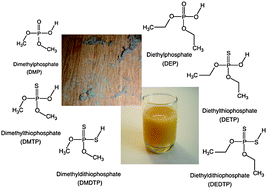A mass spectrometry-based method to measure dialkylphosphate degradation products of organophosphorous insecticides in dust and orange juice†
Abstract
Dialkylphosphates (DAPs) are urinary

* Corresponding authors
a
National Center for Environmental Health, Centers for Disease Control and Prevention, 4770 Buford Highway NE, Mailstop F-17, Atlanta, Georgia, USA
E-mail:
dbarr@cdc.gov
Fax: +1 (770) 488-0142
Tel: +1 (770) 488-7886
b Center for Children's Environmental Health Research, School of Public Health, University of California, Berkeley, CA, USA
c EPA STAR Fellow, US Environmental Protection Agency, USA
Dialkylphosphates (DAPs) are urinary

 Please wait while we load your content...
Something went wrong. Try again?
Please wait while we load your content...
Something went wrong. Try again?
G. Weerasekera, K. D. Smith, L. Quirós-Alcalá, C. Fernandez, A. Bradman, B. Eskenazi, L. L. Needham and D. B. Barr, J. Environ. Monit., 2009, 11, 1345 DOI: 10.1039/B821841B
To request permission to reproduce material from this article, please go to the Copyright Clearance Center request page.
If you are an author contributing to an RSC publication, you do not need to request permission provided correct acknowledgement is given.
If you are the author of this article, you do not need to request permission to reproduce figures and diagrams provided correct acknowledgement is given. If you want to reproduce the whole article in a third-party publication (excluding your thesis/dissertation for which permission is not required) please go to the Copyright Clearance Center request page.
Read more about how to correctly acknowledge RSC content.
 Fetching data from CrossRef.
Fetching data from CrossRef.
This may take some time to load.
Loading related content
